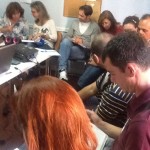Tradition Revisited & Revamped: “Something old, something new….”
- What are the good things you can draw from each of the approaches labelled traditional?
- How have you adapted them or changed them/renovated them and how do you integrate them into your teaching practice?
The discussions during the #ELTchat of November 10 had us running in two directions: there were those colleagues who wanted to leave everything old and traditional behind and there were those who had perhaps a more thoughtful and measured approach, arguing that a sound pedagogy involves sometimes satisfying the learners’ need for explanation or for some more traditional types of exercises…
Please read the transcript of the chat here, some of the major tweets here and listen to a great interview by Jeremy Harmer here if you haven’t.
So, what are the good things I have drawn from different approaches labelled traditional?
The attention to form and accuracy inherent in the grammar-translation approach is something which attracts me, perhaps because I am a teacher of English and studied Linguistics, but I accept the fact that the majority of foreign language learners do not share the same interest in language analysis (but some do), so attention to form and accuracy is something I consider important, although I would not use the same methods as this approach.
From the audiolingual method, which emphasizes controlled oral practice, albeit in the form of mechanical and often meaningless drills, I am attracted to the concept of rehearsal and using meaningful and, more often, personalized oral practices; I do believe they aid the automatization of certain lower level decisions, such as sound and sound linking articulation and the memorization of chunks and holophrases seems quite useful, especially for the beginner learner.
But there are so many activities I like from the different approaches, this post could turn into a rambly personal list. I would rather continue with some ideas of how I have used some of the typical activities in two ‘old’ approaches in a new way.
Grammar Translation
In this method:
- A text is read aloud – usually by the teacher
- The teacher explicates the text and the vocabulary by offering translations
- The teacher analyzes the grammatical patterns in the text
- Then the students read the text aloud and translate it
- Then they answer some comprehension questions
- Afterwards, they do a number of exercises (gapfills, transformations, etc)
- Often they do dictations based on the texts
Adaptation 1 – Using translation to improve a text in English
- A badly translated text is selected. The example below is from a product found on the supermarket shelf
- The students are asked to translate it back into their mother tongue
- The students are asked to notice which parts of the text have been badly translated
- The students are asked to edit and improve the translation into accurate and natural to the genre English
Comment In this way, the students are encouraged to reflect on the negative effects of translating word for word and practise grammar, vocabulary as well as text editing skills.
An alternative to the text – the video is about a badly translated interview – quite funny but practises listening, too. This one is quite advanced and focuses on tenor as well.
Adaptation 2 – Using mechanical transformation exercises to promote reflection and language awareness
- The students are given a transformation exercise.
- They have to transform sentences from the active to the passive voice or vice versa.
- It is impossible for all the sentences to be transformed and to make sense
- Even when you can change them, there will be a difference in meaning
- Students are asked to discuss how the meaning changes
Example sentences
- Many children did not receive their new coursebooks.
- “Someone has slept on this bed!”, said the princess.
- Her dress touched the ground.
- Frances was married to Ed for five years.
- etc.
Comment: This is a good activity for showing the learners that transforming sentences is usually not a great idea and that L1 users have specific (although unconscious) reasons for choosing one or the other form.
Adaptation 3 – Getting the students to ‘explicate’ and comment on the text (rather than the teacher)
In grammar translation the teacher typically talks through a text, reading it out to the students line by line, explicating and enumerating meanings of words (all of them, if possible), the grammar rules, etc., in other words, lecturing about the language in the text. In the adaptation below, the teacher still works sentence by sentence but elicits rather than tells and invites interpretations as a text is gradually revealed to the learners.
- A text is projected line by line on an overhead projector or data projector
- The text is constructed in such a way that with each line a new interpretation is possible
- The students try to interpret and re-interpret the text with each line which is revealed
Here is an example in a powerpoint. Try to interpret the text and imagine what is happening by pausing before each new line is revealed.
View more presentations from Marisa Constantinides.
Adaptation 4 – Getting the students to ask the questions (instead of the teacher)
- Cut up a suitable passage into two sections.
- Assign one to each student in a pair.
- Each student reads their part of the text and prepares to summarise it orally
- Students present their summaries to each other orally
- Tell the students they have to reconstruct their partner’s text
- Allow them to ask as many questions as they can/like within a time limit
- Remove their texts and ask them to write
- During writing it is up to you whether you allow more questions or not
- When the writing phase is over, the students can try to correct each other’s work
- Allow them access to the texts for a final check
Comment: This activity is a variation of jigsaw reading in which the reading is integrated with speaking, writing, and promotes information sharing as well as quite a lot of grammar awareness, word order, vocabulary recall, etc.
Adaptation 5 Getting the students to ask comprehension Questions (instead of the teacher)
Give the students a very short text such as the one below. Introduce it as you usually do for other texts with lead in, scanning etc. Here is an immage created by Jenny Gountani, one of my August 2010 CELTA trainees for a great lead in and prediction!
- Divide the students into pairs/groups or teams depending on the size of your class
- Get them to ask as many questions which the article does not answer
- At the endof time have teams ask their questions and the other teams supply imaginary answers.
- Later, you can ask them to select some of the answers in order to write a fuller version of the article.
Comment: This activity encourages question and answer practice, it’s quite a lot of fun to do and if you get the students to rewrite the article, they are practising elaboration, an aspect of creative thinking.
Adaptation 6 Translating articles from the mother tongue and adapting them for an English audience
- Bring a few local newspapers into class (good for monolingual classes)
- Have your students choose an article which is of local interest only
- Give them some bilingual dictionaries or access to online dictionaries
- Ask them to translate and adapt this article to be published in an English speaking newspaper
- Encourage them to make as many changes as they think are necessary to make it suitable to someone who is not familiar with the local culture and customs.
- Be available for help with grammar and to confirm lexical choices, idioms etc.
Comment: This activity promotes awareness of the students’ own culture as well as the target language culture.
From the Audiolingual approach
In this method:
- Students listen to a dialogue
- They repeat the lines for memorization
- Certain key words are substituted
- The students act out the dialogue
- Then selected patterns are drilled
Adaptation 1: The students act out a dialogue ‘with an attitude’
- Students listen to a dialogue (e.g. from the course book)
- They listen and repeat for memorisation
- Then, they choose an adjective or adverb from a poster or the board
- Each pair rehearses their dialogue using the attitudes they have picked
- Later, they act them out – rest of class must guess which adverbs they picked
Comment: This can be done with a dialogue in a PPP lesson too – you can allow variations to the theme of the dialogue or the creation of parallel dialogues which have to be enacted by adopting a new attitude. The rehearsal stage needs some monitoring and it is a particularly useful activity to raise awareness of intonation in its attitudinal function, something which is usually quite difficult to practise in class.
Adaptation 2 Using substitution tables as “sentence machines” for sentence competitions
- Write or project a substitution table
- Organize students in groups or teams
- Set a time limit and get them to make as many possible sentences
- Untrue sentences are more fun than true ones and students remember them more!
Here is an example I have given to young learners
| The best The worst The biggest The smallest The cheapest The most expensive The most uncomfortable | watches shoes roller skates sandwiches cars bicycles wines airplanes | are made are imported from | Canada Italy Greece China Pakistan The US Afganistan Nicaragua The North Pole |
Comment: The activity is very mechanical but quite good fun and the crazier the sentences, the better the students remember them!
I think should stop here – you get the idea I think that everything can be used in a different way, as long of course as we have a good reason for using the technique with a particular class. I look forward to your comments and more great ideas from your blog posts.








This info is the cat’s paaamjs!